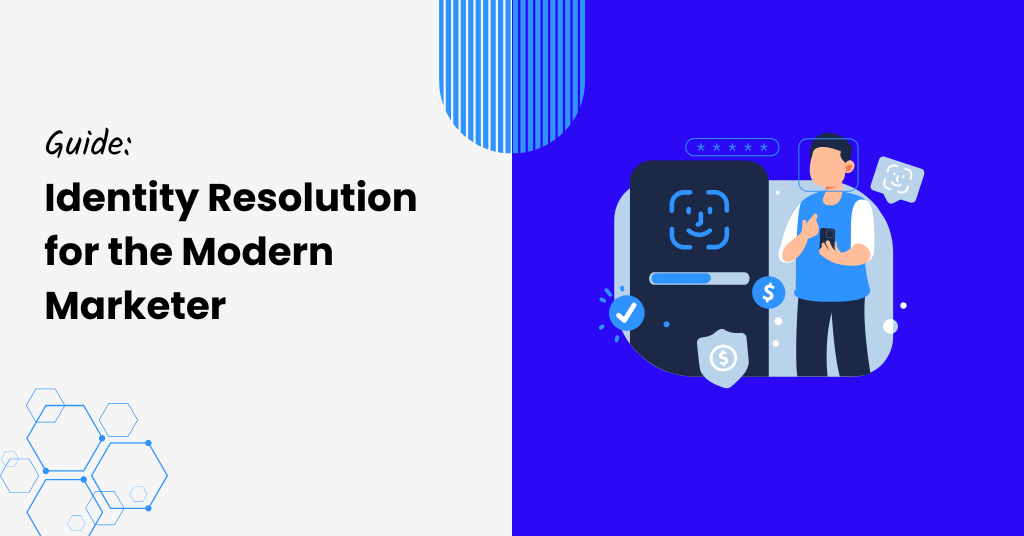Imagine this – you’re scrolling through social media and see an ad for shoes you checked out online last week. Then, you receive an email about those same shoes with a discount code just for you.
This isn’t marketing magic…it’s identity resolution at work!
Identity resolution allows brands to recognize and connect with their customers across multiple touchpoints, whether it’s email, social media, or in-store visits. Not only is this important to retailers, but it’s also important to consumers – 72% of shoppers say they expect businesses to understand their unique needs and expectations across every interaction.
So, if you’re looking to reach more customers and build customer loyalty at the same time, identity resolution is what you need.
And that’s what we are going to cover today. We’re going to break down identity resolution – what it is, how it works, and why it’s essential for modern marketers.
Let’s get started and see how you can use identity resolution to create a seamless, personalized experience for your customers.
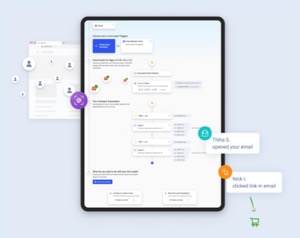
See Who Is On Your Site Right Now!
Get names, emails, phone numbers & more.
Try it Free, No Credit Card Required
What Is Identity Resolution? A Clear Definition
Identity resolution is all about connecting the dots.
At its core, identity resolution is the process of linking various data points like email addresses, social media profiles, and purchase history, to create a single, unified profile of each customer. This profile, often called an “identity graph,” becomes a comprehensive view that lets marketers understand who their customers are and how they interact across channels.
Now, you might be thinking, “Isn’t that just customer data management or what my CRM does?”
Not exactly.
While customer data management organizes and stores your data and a CRM tracks customer interactions with your brand, identity resolution goes a step further.
It connects these separate data sources, building a clear, accurate picture of each individual across touchpoints.
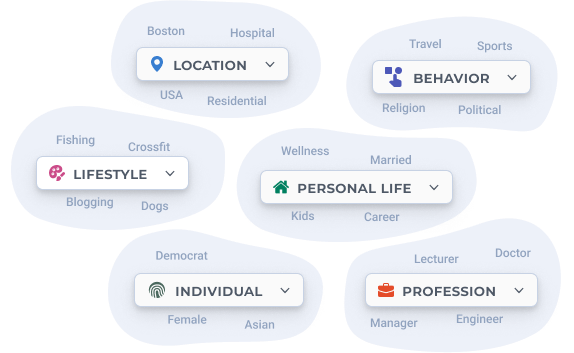
In other words, it’s not just about collecting data…it’s about connecting it.
With identity resolution, marketers can create experiences that feel personal, consistent, and relevant, no matter where or how a customer interacts with their brand.

How Identity Resolution Works: From Data Collection to Identity Graphs
Let’s take a closer look at how identity resolution actually works, step by step, from gathering data to building that all-important identity graph.
Think of it like piecing together a puzzle—each step brings you closer to seeing the whole picture.
Data Collection: Gathering from All Corners
The first step in identity resolution is gathering customer data from a variety of sources, often split into first-party, second-party, and third-party data.
- First-Party Data: This is data you collect directly from your customers through channels you control, like your website, mobile apps, and CRM. It includes information from purchases, email sign-ups, and account registrations.
- Second-Party Data: This is data shared by trusted partners (such as affiliates or co-marketing brands) and can be highly relevant since it’s collected directly from customers but shared with consent.
- Third-Party Data: Collected and aggregated by external vendors, third-party data can fill in knowledge gaps, especially around demographic and behavioral information. While third-party data is useful for a broader view, privacy regulations mean you’ll want to prioritize first-party sources when possible.
Each source is like a puzzle piece, offering a unique view of the customer. But on their own, these pieces don’t tell you much. That’s where the next step comes in.
Linking and Matching: Connecting the Dots
Once you’ve collected your data, the next step is linking these individual pieces to form a cohesive profile.
This is where identity linking and matching happen.
By comparing unique identifiers like email addresses, phone numbers, or device IDs, identity resolution tools can combine data points to build a single profile.

For instance, if a customer uses the same email for a purchase and a newsletter sign-up, linking and matching identify that both actions are from the same person.
But it’s more than just combining data. It’s creating a foundation for a real, actionable profile.
Building an Identity Graph: The Unified Customer View
All of these linked data points come together in what’s called an identity graph. An identity graph is like your brand’s version of a social network for customer data, connecting every interaction a customer has with your brand in one place.
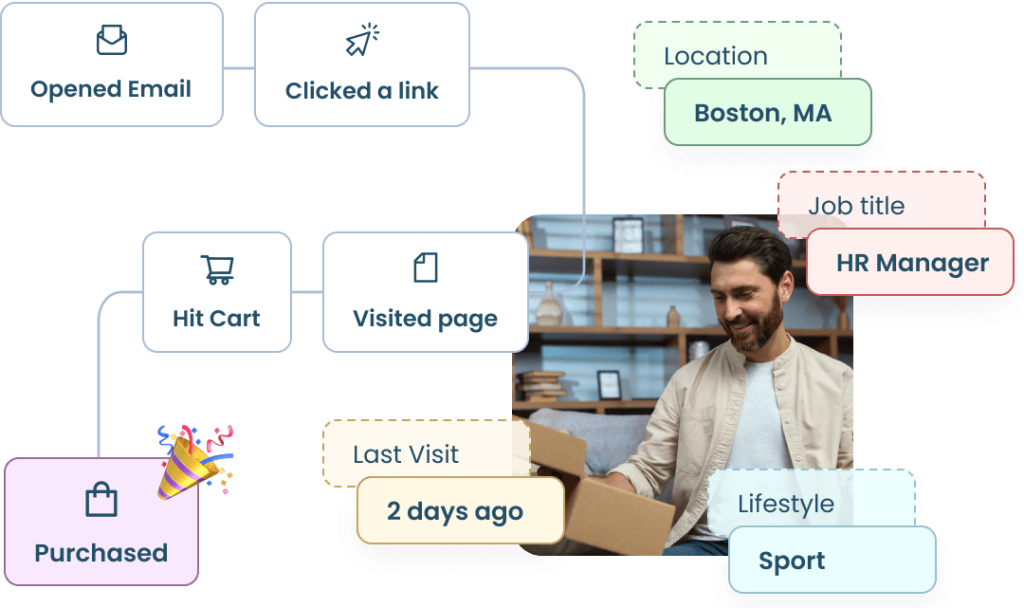
This unified view lets you understand each individual on a much deeper level, like where they shop, what they click, and how they engage with your brand over time.
Identity Verification: Ensuring Accuracy
Accuracy is key. You want to avoid merging data from different people into one profile.
Identity verification acts as a final “quality check,” ensuring that only accurate, verified data makes it into the identity graph. This reduces errors and gives you a clean, reliable view of each customer.
With data collected, matched, organized, and verified, you now have a powerful identity graph to drive personalization, enhance the customer experience, and improve targeting.
By combining data from multiple sources, linking it accurately, and verifying it, identity resolution builds a comprehensive identity graph…a complete, reliable view of each customer.

Types of Identity Resolution: Deterministic vs. Probabilistic Matching
When it comes to identity resolution, there are two main approaches:
- Deterministic matching
- Probabilistic matching
Each has unique benefits and knowing when to use each one can help online retailers deliver accurate, personalized experiences to customers at scale.
Let’s take a look at how these methods work and when they’re most useful.

Deterministic Matching: Accuracy for Loyal Shoppers
Deterministic matching is all about precision. This approach uses unique, consistent identifiers (think email addresses or loyalty program IDs) to link customer data across interactions.
For ecommerce brands, deterministic matching is ideal for tracking registered customers who frequently log in, shop on different devices, and interact with emails or loyalty offers.
If a customer signs into your website with their email and later makes a purchase through the app with the same email, deterministic matching connects these activities with near certainty.
This method is the go-to for campaigns where accuracy is essential, like targeting loyal customers with VIP perks or personalized email offers.
However, it’s limited by the need for consistent identifiers, so it may miss out on linking interactions from customers who browse anonymously or don’t use the same ID across touchpoints.
Probabilistic Matching: Flexibility for Browsers and New Customers
Unlike deterministic matching, probabilistic matching doesn’t rely on exact matches.
Instead, it uses machine learning and statistical models to analyze data points and make educated guesses that two profiles belong to the same person.
Probabilistic matching might look at device type, location, browsing behavior, and even the timing of visits to connect a web visitor with an in-store shopper who shares similar patterns.
For ecommerce, probabilistic matching is especially useful in reaching casual browsers and new customers who may not yet be registered or known.
While it’s not as precise as deterministic matching, probabilistic matching lets you expand your reach, capture more interactions, and create tailored retargeting campaigns based on likely customer behavior. This flexibility can be a game-changer for driving conversions among new or anonymous shoppers, even if they’re browsing without logging in.
Why These Methods Matter to Marketers
In ecommerce, deterministic matching gives you confidence in reaching your repeat customers with high accuracy, while probabilistic matching allows you to expand your reach and capture interest from new visitors.
By blending both approaches, online retailers can deliver personalized, relevant shopping experiences that build customer loyalty and drive sales.

Key Benefits of Identity Resolution for Marketers
Identity resolution brings all your customer data together, helping you create better experiences, boost conversions, and make your marketing dollars go further.
Here are a few reasons why it’s a must-have tool for ecommerce marketers:
1. Enhanced Personalization: Crafting Unique Experiences
Shoppers want brands that really “get” them.
With identity resolution, you’re not just guessing what they want, you’re tailoring every interaction based on a complete view of their preferences and behaviors.
Say you’ve got a customer who keeps browsing your sneaker collection on the website but finishes purchases in the app. Thanks to identity resolution, you can make sure they get tailored sneaker suggestions across all platforms, building consistency and trust that keeps them coming back.
2. Improved Attribution: Seeing the Full Customer Journey
Customers often move between Instagram, your website, and your app, so knowing what actually influences their purchase decisions can be tricky.
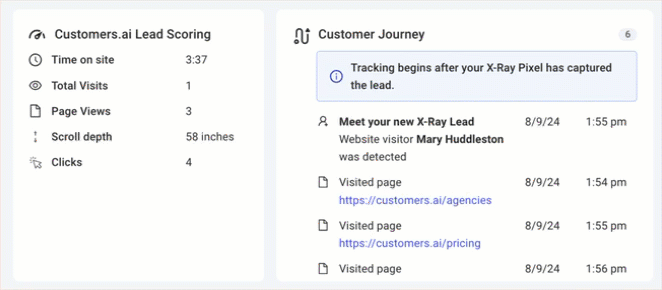
Identity resolution connects the dots, showing you how customers interact across channels. Did an Instagram ad prompt them to buy in the app? Did they read a review in your email before clicking “Buy Now”?
This clarity helps you focus on what works best and drop what doesn’t.
3. Increased ROI: Making Every Marketing Dollar Count
Every marketing dollar matters and identity resolution helps you spend wisely by targeting customers who are more likely to convert and cutting out generic retargeting.
Imagine following up with a customer who bought a winter jacket by suggesting boots or accessories that match. This approach keeps your messaging relevant and boosts your chances of converting those follow-up campaigns into additional sales, maximizing your ROI.
4. Better Customer Segmentation: Target with Precision
When you understand your customers better, you can segment them in more meaningful ways.
With identity resolution, you can go beyond basic demographics and start targeting based on behaviors, preferences, or even purchase frequency.

Maybe you have a segment of customers who only shop during sales or others who love new product drops. Identity resolution helps you segment your audience more accurately, allowing you to craft messaging that resonates with each unique group.
5. Higher Customer Retention: Building Loyalty
Personalized experiences build loyalty. Identity resolution allows you to create that “VIP treatment” effect by recognizing each customer’s shopping habits and preferences.
When you acknowledge past purchases or reward loyalty across channels, it strengthens relationships and turns one-time buyers into brand advocates, significantly boosting lifetime value.
From delivering personalized recommendations to accurately targeting different segments and maintaining data privacy, identity resolution supports a customer-focused marketing approach that goes beyond reach and truly connects with people.

Real-Life Signals: Recognizing When You Need Identity Resolution
Sometimes, the signs that you need identity resolution are right in front of you.
Here are some clear signals that your customer data strategy may be falling short and that it’s time to consider an identity resolution solution.
1. Inconsistent Customer Data Across Platforms
One of the biggest frustrations for both customers and marketers is inconsistent information. If a customer’s purchase history is only available in your CRM but not accessible to your email marketing team, or if someone’s preferences aren’t recognized across platforms, it creates a fragmented experience.
Example: A customer updates their email preferences on your website but still receives outdated offers via email. If you’re seeing these types of disconnects, identity resolution can bring it all together, ensuring your customer’s profile is consistent across channels.
2. Poor Ad Targeting Results
If you’re struggling with ad targeting results, identity resolution could be the missing piece.
Many brands spend a lot on ads, only to find their clicks and conversions aren’t reflecting their efforts. This could be because you’re targeting the same person in different ways on different platforms or not reaching the right audiences at all.
Example: Your Facebook ads are driving clicks, but the same customers are getting retargeted on Instagram with products they’ve already purchased. Identity resolution helps you refine your targeting so each customer gets relevant ads, only when they need them.
3. Challenges with Cross-Channel Attribution
Do you know which touchpoints are truly driving sales?
Without identity resolution, it’s tough to track a customer’s journey across multiple channels and devices. You might know where the last click came from, but you miss the full picture of how your emails, social media, and website all worked together to influence the purchase.
Example: A customer browses products on your website, later clicks an email offer, and finally purchases through your app. Without identity resolution, it’s hard to connect these actions back to the same individual. With it, you get a more complete view of what worked, allowing you to adjust your marketing efforts accordingly.

Webinar: 2024 Playbook
Increasing Traffic & Conversions in the Age of AI
4. Limited Ability to Personalize Experiences
If your personalization efforts are falling flat, it’s a sign your customer data may not be unified. When data is siloed, you can’t deliver personalized experiences because each team or platform only has a partial view of the customer. Identity resolution bridges these silos, letting you understand preferences and behaviors across the board.
Example: If a customer who regularly buys baby products starts exploring toddler items, identity resolution can make sure that your recommendations across channels shift to reflect this. It’s all about keeping the customer experience relevant, no matter where they’re interacting with you.
5. High Costs Due to Duplicate or Redundant Marketing Efforts
Running ads or campaigns for the same customer multiple times due to duplicate profiles is a waste of resources. Identity resolution helps you streamline these efforts by consolidating duplicate records and creating one accurate customer profile. This allows for more efficient spending and a better customer experience.
Example: Instead of sending multiple welcome offers to the same person because they signed up through different email addresses, identity resolution can consolidate their data into a single profile, allowing you to offer new promotions more effectively.
If any of these scenarios sound familiar, it may be time to explore identity resolution. By addressing these common issues, identity resolution helps you build a more cohesive, personalized, and cost-effective approach to marketing.

Identity Resolution Pitfalls: Mistakes Marketers Make (and How to Fix Them)
Getting identity resolution right can be transformative for your marketing efforts, but there are some common mistakes that can throw you off course.
Here’s a look at some of the biggest pitfalls marketers face and how to avoid them.
1. Neglecting Data Accuracy
One of the most common mistakes in identity resolution is not prioritizing data accuracy.
If your data isn’t clean or reliable, it’s impossible to build an accurate profile of each customer. Duplicate records, outdated information, and incorrect identifiers all lead to inconsistent experiences and missed opportunities.
How to Fix It: Regularly audit your data to ensure it’s accurate and up to date. Invest in data-cleaning tools that can automatically flag duplicates, incorrect formats, and incomplete records. Also, make it a practice to validate data at the point of collection, so you’re starting with reliable information.
2. Overlooking Privacy Compliance
Privacy regulations like GDPR and CCPA require careful handling of personal data and failing to comply can lead to hefty fines and damage to your brand’s reputation. A common pitfall is implementing identity resolution without building in privacy compliance measures, which can expose your company to risks.
How to Fix It: Make privacy a foundational part of your identity resolution strategy. Always obtain clear consent from customers before collecting or combining their data. Regularly review your practices to ensure compliance with current regulations, and consider working with a data protection officer or legal advisor to stay on top of changes in privacy laws.
3. Relying Solely on Probabilistic Matching
Probabilistic matching uses algorithms to link data points based on statistical likelihoods rather than exact identifiers, which can be powerful but isn’t foolproof.
Relying exclusively on probabilistic matching often leads to errors, such as merging profiles of different individuals who happen to share similar characteristics.
How to Fix It: Use a combination of deterministic and probabilistic matching to balance accuracy with reach. Deterministic matching (based on exact matches like email addresses) provides a higher level of certainty, while probabilistic matching can expand your reach when data is less structured. This blended approach helps minimize errors and maximize the accuracy of your customer profiles.
See the Visitors Hiding on Your Site
Book a demo of Customers.ai’s U.S. website visitor identification, customer journey insights and remarketing platform to skyrocket conversions and sales.
4. Ignoring Cross-Departmental Data Silos
Data silos are a common issue in larger organizations where different teams manage their own data without sharing it effectively.
When customer data is siloed across departments, it leads to incomplete profiles, reducing the effectiveness of your identity resolution efforts and creating an inconsistent customer experience.
How to Fix It: Break down these silos by implementing a centralized customer data platform (CDP) or a similar solution that integrates data from various sources. Regularly encourage cross-department collaboration to ensure that marketing, sales, and customer service teams are all contributing to and benefiting from a unified customer view.
5. Failing to Update Identity Graphs Regularly
Customer data is constantly changing—people move, change email addresses, and update phone numbers. If your identity graph isn’t updated regularly, it quickly becomes outdated and unreliable, leading to inaccurate targeting and poor customer experiences.
How to Fix It: Set up automated processes that update your identity graph in real-time or at regular intervals. Ensure that your system flags changes in customer data so that profiles stay current. An up-to-date identity graph means your marketing efforts will be more accurate, relevant, and effective.
6. Overlooking the Customer’s Perspective
Identity resolution often focuses on internal benefits like data consolidation and personalization, but it’s easy to overlook how these practices impact the customer experience. Over-targeting, for example, can feel invasive, especially if a customer feels like they’re being “followed” by the brand.
How to Fix It: Balance personalization with privacy and frequency. Only target customers with messages that truly add value, and consider the cadence of your campaigns to avoid oversaturation. Regularly review your approach from the customer’s perspective and make adjustments to keep interactions relevant but respectful.
Avoiding these common pitfalls can help you get the most out of your identity resolution efforts. By focusing on data accuracy, compliance, a balanced matching approach, and the customer experience, you can build an effective strategy that delivers results without missteps.

Customer Experience in Action: What Identity Resolution Actually Looks Like for Shoppers
What does identity resolution really mean for customers?
Let’s look at some real-world scenarios that show how it makes everyday shopping smoother, more relevant, and even a bit more exciting.
Scenario 1: Returning Visitor with Tailored Recommendations
Imagine a shopper named Sarah. She’s visited your website a few times, browsing winter jackets, but hasn’t made a purchase yet.
Thanks to identity resolution, you’ve recognized her return and connected her past browsing behavior across devices. When Sarah lands on your homepage this time, she sees a selection of jackets that fit her style and price range based on her previous clicks. It’s a personalized experience that feels intuitive, and with one click, she’s able to add her favorite jacket to her cart.
Why It Matters: Identity resolution brings past interactions into the present, showing Sarah the products she actually cares about, no matter what device she’s on. This level of personalization boosts her chances of making a purchase, while she feels like the brand “gets” her preferences.
Scenario 2: Loyalty Members Receiving Consistent, Exclusive Offers Across Platforms
Now let’s say we have Mike, a loyalty program member who’s been shopping with your brand for years. He follows your brand on social media, frequently checks emails for offers, and sometimes shops in-store.
When your latest promotion rolls out, identity resolution ensures Mike gets the same special offer, exclusive to loyalty members, on Instagram, via email, and when he logs into his account online. Even if he visits a store, the offer is applied to his purchase, creating a seamless experience.
Why It Matters: Identity resolution allows you to treat Mike as one unified customer, not just as isolated interactions. By recognizing his loyalty status across platforms, you’re giving him a consistently valuable experience that strengthens his relationship with your brand.
Scenario 3: First-Time Customer Becoming a Repeat Buyer
Meet Emily, a first-time buyer who recently purchased a yoga mat on your website. After the purchase, she begins seeing relevant ads and emails with recommendations for other products, like resistance bands and fitness apparel.
Over time, identity resolution helps your brand track her interactions, revealing a pattern: she’s consistently interested in wellness products. As a result, your future communications stay tailored to Emily’s interests, guiding her back to your site when she’s ready to shop again.
Why It Matters: This follow-up personalization shows that you understand Emily’s interests beyond her initial purchase. It encourages her to return, not just as a one-off customer, but as someone with a growing interest in your brand.
From personalized recommendations to smooth omnichannel shopping, identity resolution makes it possible to offer the kind of seamless, relevant experiences customers expect today.

Identity Resolution Best Practices for the Modern Marketer
To get the most out of identity resolution, it’s crucial to keep your data clean, profiles current, and customers’ trust intact.
Here are some best practices, complete with steps to help you build a reliable, customer-friendly strategy.
1. Use High-Quality Data: Accuracy and Relevance Are Key
High-quality data is the foundation of effective identity resolution. Outdated emails, incomplete profiles, and duplicate records can lead to mismatched profiles and a frustrating customer experience.
Steps:
- Conduct Regular Data Audits: Set a schedule for reviewing your data sources to identify duplicates, incomplete records, or outdated information.
- Invest in Data-Cleaning Tools: Use tools that help automatically detect and correct errors, such as duplicates or incorrect formats.
- Validate Data at Collection: Wherever possible, confirm data accuracy at the point of collection, like verifying emails during sign-ups, so you start with reliable information.
2. Keep Identity Graphs Up-to-Date to Stay Relevant
Customer information is constantly evolving. If your identity graph doesn’t stay current, you risk losing relevance and missing opportunities for meaningful engagement.
Steps:
- Automate Profile Updates: Use automation to update profiles as soon as new data is collected, such as new purchases, preferences, or contact information.
- Set Data Freshness Checks: Periodically review data sources to ensure that information like email addresses, phone numbers, and preferences are still valid.
- Create an Update Protocol: Establish guidelines for how often different types of data should be reviewed and updated, keeping critical information refreshed regularly.
3. Balance Privacy with Personalization: Respect Customer Boundaries
Customers value personalization, but only when it’s done respectfully. Building trust requires a careful approach to privacy and transparency.
Steps:
- Obtain Clear Consent: Make sure customers are fully aware of how their data will be used and ask for explicit consent when collecting personal information.
- Be Transparent About Data Usage: Clearly communicate to customers what data is being collected, how it’s being used, and the benefits they’ll receive.
- Allow Easy Data Access and Opt-Out Options: Give customers the ability to view, update, or remove their data if they choose. Ensuring data is accessible and opt-outs are simple builds trust and keeps your data compliant.
By following these best practices, you’ll keep your identity resolution strategy accurate, relevant, and respectful—delivering a great experience for your customers and fostering long-term trust.

See Who Is On Your Site Right Now!
Get names, emails, phone numbers & more.
Try it Free, No Credit Card Required
Identity Resolution Tools: What to Look for in a Solution
When selecting an identity resolution solution, it’s essential to consider features that align with your marketing goals and operational needs. Here’s what to look for and a brief overview of leading tools in the market.
Features to Consider in Identity Resolution Solutions
- Real-Time Updates: The ability to process and reflect customer data changes instantly ensures your marketing efforts are always based on the most current information.
- Cross-Channel Compatibility: Effective solutions integrate data from various sources—websites, mobile apps, social media, and in-store interactions—to provide a unified customer view.
- Scalability: As your business grows, your identity resolution tool should handle increasing data volumes without compromising performance.
- Data Privacy Compliance: Ensure the tool adheres to regulations like GDPR and CCPA, maintaining customer trust and legal compliance.
- User-Friendly Interface: An intuitive platform facilitates easier adoption and efficient use by your marketing team.
Leading Identity Resolution Tools
- Customers.ai: A comprehensive platform that offers real-time identity resolution, integrating data across multiple channels to create unified customer profiles. Its scalability and user-friendly interface make it suitable for businesses of all sizes.
- Tealium: Provides a robust customer data platform with strong identity resolution capabilities, focusing on real-time data integration and cross-channel compatibility.
- Amperity: Offers advanced identity resolution features, including entity resolution and data enrichment, to help businesses manage and unify customer identities effectively.
- Experian Identity Resolution: Offers solutions to help businesses accurately identify, verify, and manage customer data across multiple platforms and devices.
- Treasure Data: Provides a customer data platform with identity resolution capabilities, focusing on integrating data from various sources to create unified customer profiles.
- Zeta CDP+: Provides a customer data platform with identity resolution features, enabling businesses to gather comprehensive customer profiles for enhanced marketing strategies.
When evaluating these tools, consider how each aligns with your specific needs, such as the scale of your operations, the complexity of your data sources, and your compliance requirements.
Choosing the right identity resolution solution can significantly enhance your marketing effectiveness by providing a clearer understanding of your customers.

Setting Goals with Identity Resolution: 7 Metrics to Track
Implementing identity resolution is only half the battle; knowing how to measure its success is where the real value lies.
To get the most out of your efforts, here are some key metrics that help you track the effectiveness of identity resolution.
1. Customer Engagement Rate
Customer engagement is one of the clearest indicators of how well your identity resolution efforts are resonating. By creating unified customer profiles, you can deliver personalized content that feels relevant, increasing engagement across emails, ads, and social media.
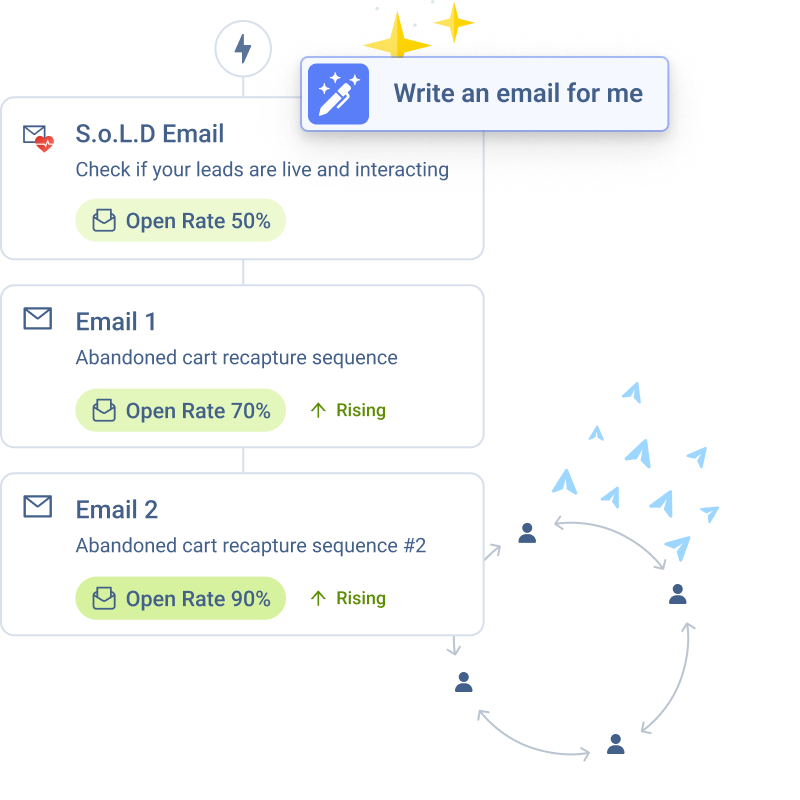
Metric to Track: Look at open rates, click-through rates, and time spent on personalized landing pages. Higher engagement rates indicate that your targeting is more precise and your content is connecting with the right audience.
2. Conversion Rate from Cross-Channel Campaigns
Identity resolution allows you to create consistent, targeted campaigns across channels, which can boost conversion rates by delivering a seamless customer experience.
By tracking conversion rates from campaigns that use identity resolution, you can measure how well cross-channel consistency is driving purchases.
Metric to Track: Track conversions from channels like social media ads, email, and in-app messages to see how many customers make a purchase after interacting with multiple touchpoints. Improved conversion rates suggest that your cross-channel targeting and messaging are effectively guiding customers toward a purchase.
3. Ad Targeting Accuracy
If one of your goals with identity resolution is to enhance ad targeting, you’ll want to see a reduction in wasted ad spend and an increase in ad relevance. With unified profiles, you can avoid redundant targeting and create personalized ads that drive real results.
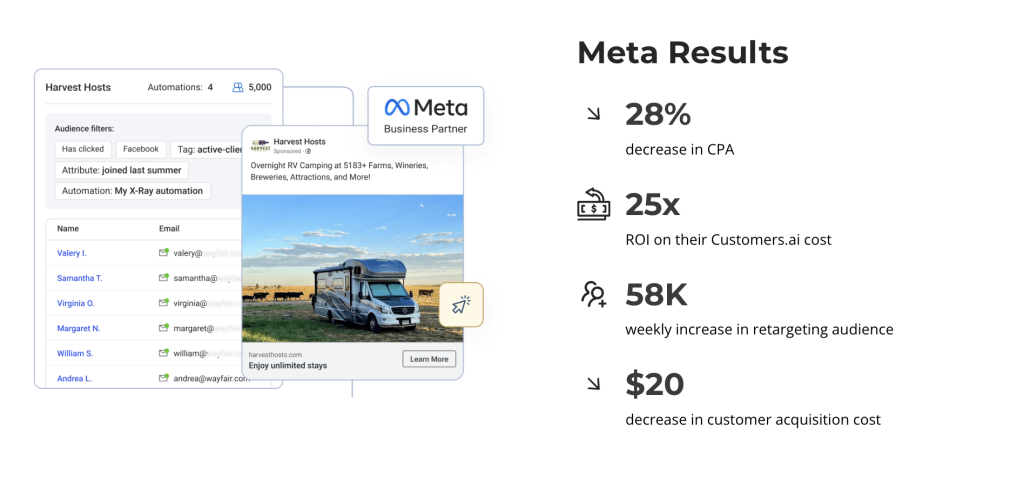
Metric to Track: Look at metrics like cost per acquisition (CPA) and click-through rate (CTR) for personalized ads. Lower CPA and higher CTR are signs that your ads are reaching the right people and making an impact.
4. Customer Retention Rate
One of the long-term goals of identity resolution is to boost customer retention by improving loyalty and ensuring customers receive consistent, relevant experiences. When customers feel understood and valued, they’re more likely to return.
Metric to Track: Monitor repeat purchase rates and retention rates to gauge how well identity resolution is helping you retain customers. An increase in repeat purchases or subscriptions shows that your brand is successfully building relationships and loyalty.
5. Lifetime Value (LTV)
Improving lifetime value (LTV) is a major goal for brands using identity resolution. By providing tailored experiences, upsell opportunities, and timely re-engagement, you can increase each customer’s long-term value to the brand.
Metric to Track: Track LTV by monitoring average revenue per user over time, especially among segments with personalized experiences. An increase in LTV shows that identity resolution is helping you maximize the potential of each customer relationship.
6. Reduction in Duplicate Profiles
Accurate identity resolution often leads to a decrease in the number of duplicate profiles within your customer database. A cleaner database means less redundancy and better targeting accuracy, which is beneficial for both engagement and cost efficiency.
Metric to Track: Measure the number of duplicate profiles over time. A reduction in duplicates demonstrates that your identity resolution efforts are keeping your data clean and ensuring more accurate customer insights.
7. Privacy Compliance Metrics
With data privacy becoming an increasingly significant focus, tracking compliance metrics is essential. Identity resolution should align with privacy standards, so tracking how well your data collection and storage practices comply with regulations can prevent future issues.
Metric to Track: Assess metrics like consent opt-ins, data access requests, and the time taken to address privacy concerns. High compliance and quick response times to data access requests show that your identity resolution strategy is customer-centric and privacy-focused.
These metrics not only help you measure success but also provide valuable insights for refining your strategy and ensuring that each customer interaction is as effective and meaningful as possible.

The Evolution of Identity Resolution: Where It’s Heading and What It Means for Marketers
Identity resolution has come a long way from simply linking data points. Today, it’s evolving into a sophisticated blend of technology, privacy practices, and customer experience strategies.
Here’s a look at where identity resolution is heading, how emerging trends will shape it, and what these shifts mean for marketers focused on ecommerce and customer-centric strategies.
AI and Machine Learning Are Boosting Identity Resolution Capabilities
Artificial intelligence and machine learning are playing increasingly significant roles in identity resolution.
AI-powered algorithms can process vast amounts of data and identify complex patterns much faster than traditional methods. These capabilities are especially useful for probabilistic matching, where AI can make educated predictions about which data points likely belong to the same customer, even without exact matches.
For marketers, the integration of AI means identity resolution can become more accurate and responsive, enabling real-time updates and immediate insights into customer behavior.
AI-driven insights allow brands to predict customer needs, offer timely recommendations, and deliver personalized experiences with precision. This shift will ultimately make identity resolution a more dynamic tool for creating seamless, data-driven customer journeys.
The Rise of Cookieless Tracking Is Changing the Game
With major browsers phasing out third-party cookies, marketers are finding new ways to track and engage customers. Identity resolution is becoming essential in a cookieless world, where marketers can’t rely on traditional tracking methods.
Instead, brands are turning to identity graphs, which unify customer interactions without depending on cookies, by leveraging alternative identifiers like email addresses, device IDs, and behavioral patterns.
For marketers, this transition to cookieless tracking means rethinking data strategies and placing more importance on first-party data.
By building a robust identity graph that isn’t reliant on cookies, brands can maintain continuity in customer interactions and continue offering relevant, personalized experiences without sacrificing privacy.
Increased Focus on Omnichannel Experiences and Seamless Customer Journeys
As customer expectations for seamless, omnichannel experiences grow, identity resolution will continue to evolve to support these journeys.
Customers expect a unified experience whether they’re browsing online, interacting on social media, or shopping in-store. This demand means identity resolution must integrate data across multiple touchpoints to create a consistent experience.
For marketers, this shift towards omnichannel means that identity resolution tools will need to handle larger volumes of cross-platform data and ensure that customer profiles are up-to-date in real time.
The goal is to create a true 360-degree view of each customer that informs every interaction, from marketing and sales to customer support.
Implications for the Future of Ecommerce and Customer-Centric Marketing
With these trends driving the future of identity resolution, marketers will see increasing opportunities to personalize, predict, and enhance customer experiences. However, these advances also bring new responsibilities.
Marketers will need to prioritize privacy, leverage AI responsibly, and embrace first-party data strategies that foster trust and transparency.
In ecommerce, the focus on identity resolution will continue to shift toward building deeper, value-driven relationships.
Marketers who succeed will be those who can harness identity resolution to deliver meaningful experiences while respecting customer privacy. As these technologies and practices evolve, brands that stay agile and customer-focused will be best positioned to thrive in a privacy-conscious, AI-powered, cookieless future.

Conclusion: Identity Resolution as a Key to Customer-Centric Marketing
Let’s face it—customers today expect brands to know them, remember them, and make their experience as smooth as possible. Identity resolution is what makes all that possible, helping you deliver those seamless, personalized touches that keep people coming back.
By connecting the dots between every interaction, identity resolution lets you see the full picture of each customer. And that means you can send offers they actually want, follow up at the right times, and avoid those awkward moments when they feel like just another number.
The result? Happier customers, stronger loyalty, and a real boost to your marketing efforts.
So, whether you’re just starting out with identity resolution or ready to level up, there’s no better time to dive in.
Putting customers at the heart of your strategy is more than good business. It’s the key to building a brand they’ll keep coming back to.

See Who Is On Your Site Right Now!
Get names, emails, phone numbers & more.
Try it Free, No Credit Card Required
Important Next Steps
- See what targeted outbound marketing is all about. Capture and engage your first 500 website visitor leads with Customers.ai X-Ray website visitor identification for free.
- Talk and learn about sales outreach automation with other growth enthusiasts. Join Customers.ai Island, our Facebook group of 40K marketers and entrepreneurs who are ready to support you.
- Advance your marketing performance with Sales Outreach School, a free tutorial and training area for sales pros and marketers.
FAQ: Everything You Need to Know About Identity Resolution
How does identity resolution help brands understand their customers better?
Identity resolution connects data from various sources, creating a unified profile that shows each customer’s journey, preferences, and behaviors across touchpoints.
Why is identity resolution important in marketing?
It enables personalized, consistent marketing across channels, helping brands connect with customers on a deeper level and improve customer loyalty.
What is an identity graph?
An identity graph is a database of customer profiles that compiles identifiers like emails, phone numbers, and device IDs to create a unified customer view.
How does identity resolution enhance customer experience?
It allows brands to personalize interactions and ensure that each customer gets relevant offers, messages, and recommendations across platforms.
What’s the difference between deterministic and probabilistic matching?
Deterministic matching uses exact data matches (like an email), while probabilistic matching uses statistical models to connect data points that likely belong to the same person.
What role does AI play in identity resolution?
AI enhances identity resolution by analyzing large datasets to identify patterns and make accurate matches faster, even across complex data sources.
How does identity resolution support cross-channel marketing?
By linking customer interactions across channels, identity resolution enables brands to provide a cohesive experience whether the customer is on social media, email, or in-store.
Is identity resolution only for large companies?
No, identity resolution can benefit businesses of all sizes. Scalable solutions and tools make it accessible even for small and medium-sized companies.
How does identity resolution impact ad targeting?
It improves ad targeting accuracy by ensuring you’re delivering relevant messages to the right people and avoiding duplicate or redundant targeting.
What are some common identity resolution mistakes?
Common mistakes include relying solely on probabilistic matching, neglecting data accuracy, and overlooking privacy compliance.
What’s the benefit of real-time data in identity resolution?
Real-time data keeps customer profiles current, allowing brands to respond to behavior changes instantly and deliver timely, relevant content.
How does identity resolution improve customer engagement?
By creating personalized interactions, identity resolution enhances engagement rates, as customers feel understood and valued by the brand.
What are identity resolution tools, and how do they work?
These tools compile data from multiple sources to create unified profiles, allowing marketers to view and understand each customer’s journey across platforms.
What is cross-channel compatibility in identity resolution?
Cross-channel compatibility ensures that a customer’s profile is updated and accessible across all channels, making it possible to provide a seamless experience.
How does identity resolution benefit e-commerce brands?
E-commerce brands use identity resolution to create personalized shopping experiences, improve product recommendations, and enhance customer retention.
What privacy regulations should marketers consider in identity resolution?
Regulations like GDPR and CCPA require brands to handle customer data responsibly, with clear consent and transparency.
How does identity resolution contribute to customer-centric marketing?
It allows brands to understand and prioritize individual customer needs, creating a more personalized and customer-centric experience.
What is first-party data, and why is it important for identity resolution?
First-party data is information collected directly from customers. It’s crucial for building accurate, privacy-compliant profiles without relying on third-party data.
Can identity resolution help reduce customer acquisition costs?
Yes, by improving targeting accuracy and reducing wasted ad spend, identity resolution can lower customer acquisition costs.
How often should customer profiles be updated in identity resolution?
Ideally, profiles should be updated in real-time or as frequently as possible to ensure the data reflects the latest customer interactions and preferences.
What’s the difference between identity resolution and customer data management?
While customer data management stores and organizes data, identity resolution connects these data points to create a cohesive customer profile.
How does identity resolution drive conversion rates?
By delivering relevant, timely messaging across channels, identity resolution helps brands guide customers through the buying journey, increasing conversion rates.
Why is data accuracy critical in identity resolution?
Accurate data is essential for building reliable profiles; inaccurate data can lead to mistargeting, wasted ad spend, and poor customer experience.
How does identity resolution enhance customer loyalty?
Identity resolution helps brands deliver personalized interactions that make customers feel valued, which encourages repeat purchases and long-term loyalty.
What metrics can track the success of identity resolution?
Key metrics include customer engagement rate, conversion rate, ad targeting accuracy, customer retention rate, and lifetime value.
